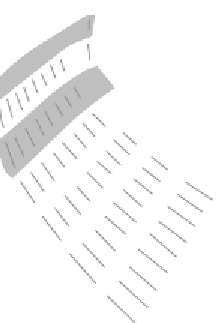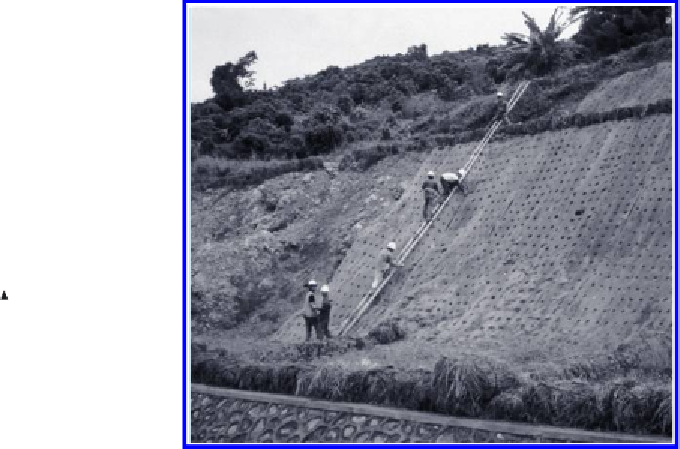Environmental Engineering Reference
In-Depth Information
Direction
Of flow
Trench or extend
top of blanket at
top of slope
Ensure blanket is
secure along entire
slope with staples
Overlap blankets
FIGURE 20.7
Erosion Control Blanket
Water erosion of tailings or waste-rock management facilities during the operational
phase can be avoided by using the following techniques (EC 2004): (1) covering the sloping
surfaces of the impoundment with a protective layer such as gravel, a soil and grass cover, a
geo-fabric and grass cover, or some form of synthetic coating; (2) impregnating the surface
layer of the tailings with a chemical which can repel water or result in particle binding, such
as a silica compound, cement, porcelain, bitumen or bentonite; and (3) using the chemical
properties of the tailings, to assist in particle binding.
●
The blanket or mat should come
into complete contact with the soil.
●
The top of the blanket should be
trenched-in (there should be no
evidence of water fl owing under
the blanket or mat).
●
Mulch should not be placed in
concentrated fl ow areas.
●
Check to see if erosion is occurring
in mulched areas (more mulch may
need to be applied).
●
Install blankets and mats so that sec-
tions are overlapped about 10 cm
and staples are about 30 cm apart
on tops and about 60 cm apart
down the sides and in the middle.
Managing Ground Cover
Preserving existing vegetation and re-vegetating disturbed land as soon as possible after dis-
turbance are the most effective ways to control erosion (US EPA 1992). Vegetative stabilization
includes temporary or permanent seeding and sodding. Vegetative stabilization helps prevent
erosion at exposed mining or construction sites by re-establishing vegetation on exposed soils.
Native and non-invasive species are highly preferred to introduced grasses
(
Figure 20.9
).
The steps involved in revegetation typically include seedbed preparation, fertilizing, lim-
ing (to neutralize soil acidity), seeding, mulching and maintenance. Bio-solids (the residual
solid fraction, primarily organic material, of processed sewage sludge or of other sludge
derived from organic waste sources) are a low-cost alternative to the use of commercially
available lime and fertilizer. Bio-solids are available in various forms, such as sewage sludge
or pulp mill or palm oil mill wastes. They are benei cial in creating a soil substitute and in
developing the soil structure through the addition of signii cant quantities of organic matter.
A vegetative cover shields the ground surface from the impact forces of sunlight and
rainfall, attenuates surface water runoff velocity, holds soil particles in place and main-
tains the capacity of soil to absorb water. The combined effect is to stabilize disturbed land
against erosion.
Vegetative cover can be grass, trees, legumes, or shrubs. In most cases, it will be neces-
sary to i rst provide a ground cover with grass or other quick growing species to provide
erosion protection within a short time. Permanent seeding and planting follow, where a
long-living plant cover is desired. Trees are especially effective in areas with unstable soil
conditions or on steep slopes, and a closed canopy forest cover is effective in reducing the
impact of precipitation.
Table 20.1
outlines a sample revegetation plan.
Trees are especially effective
in areas with unstable soil
conditions or on steep slopes




















































Search WWH ::

Custom Search